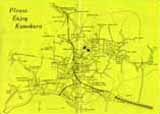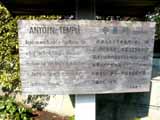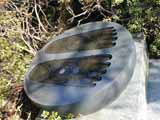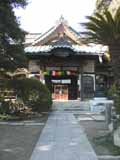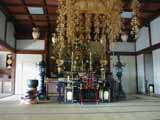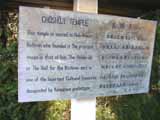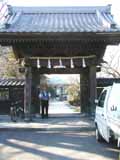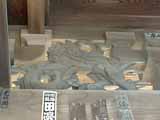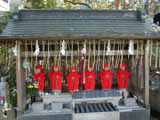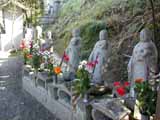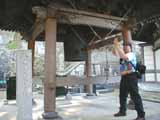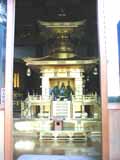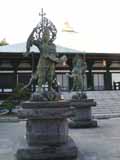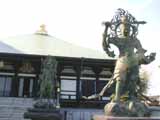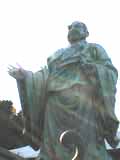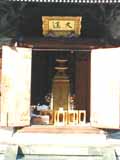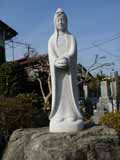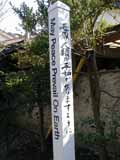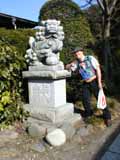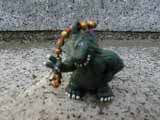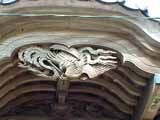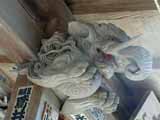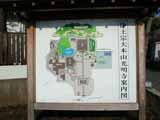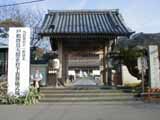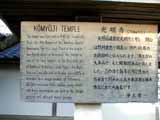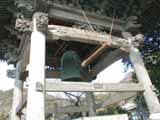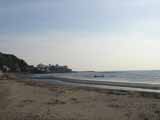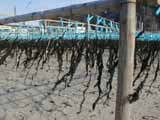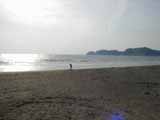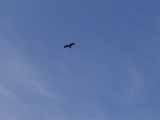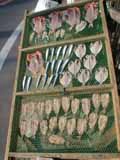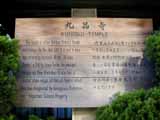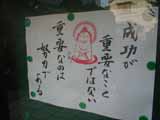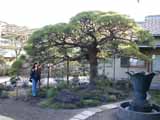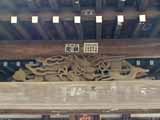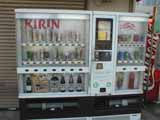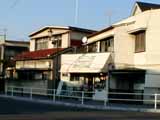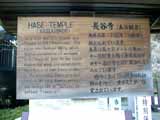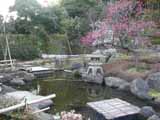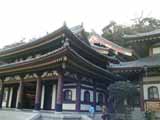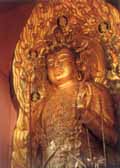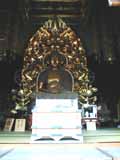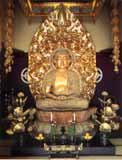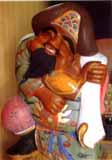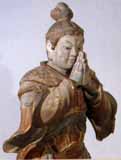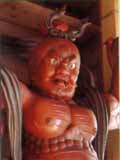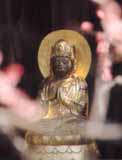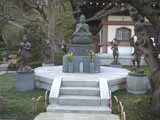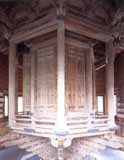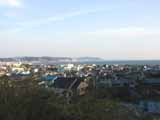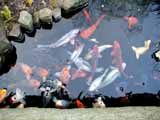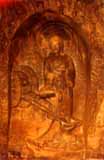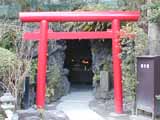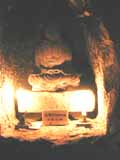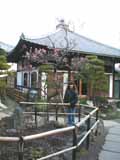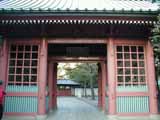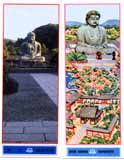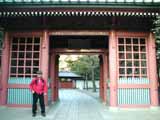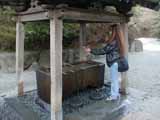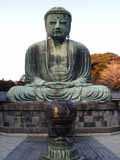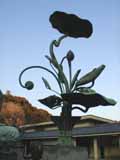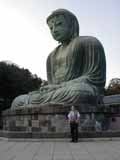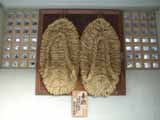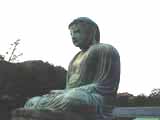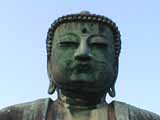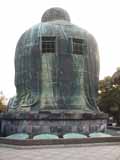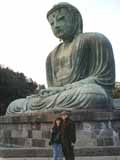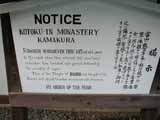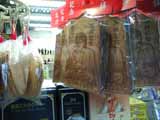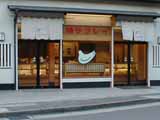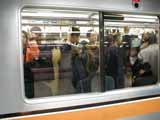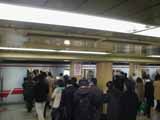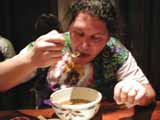Since Ting had wrapped up her Tumbleweed business yesterday, we
decided that today's holiday destination would be the town of Kamakura,
about an hour southwest of Tokyo on the JR Yokosuka line.
Kamakura became the seat of power for the first Shogunate rulers
of Japan about 1200 AD, and prospered as the military capital during the
next 150 years. By the mid 15th century Kamakura had entered a period of
decline, and today it is another sleepy town on the coast.
Although friends had given us recommendations for a hike starting
at Kita-Kamakura station and traveling from temple to temple through the
hills, ending at Hasedera temple, we were snoozing on the train, and missed
the proper station. Rather than waiting for the next return train to go
back to Kita-Kamakura, we decided to disembark at the main station in the
center of town and make our own tour up on the spot.
After winding our way through the narrow streets of the shopping
district surrounding the train station, we set out to the east, heading
towards Anyoin Temple, about a half mile away. Although our tiny guidebook
referred to Anyo-in as the Temple of Azaleas, it was too early in the season
for any blooms, so we had to settle for pictures of the various statues.
As you can see, it was pretty deserted... no one was around, so we left
an offering in the box at the front of the temple and moved on down the
street.
Our next stop turned out to be Choshoji Temple, as somehow we missed
the side street leading off towards Myohoji and Ankokuronji Temples. Tucked
against the side of a hill, we explored only about half of the Temple grounds,
as there were prayer ceremonies taking place in the main temple and several
smaller shrines. We did not feel that it was appropriate to be poking around
under the circumstances.
Overall, Choshoji was much more impressive than Anyoin, though perhaps
this is just a matter of it being more in favor at present. In the last
picture there, 'Another Small Shrine,' you can just barely make out the
hands of a priest who was chanting and reading prayers in a solemn voice
throughout our visit.
We decided then that our next stop would be Komyoji temple, to the
south, but failing to find the forest path on the hillside as indicated
by our map, we ended up walking along the quiet back streets of the town.
Every now and then we would be passed by someone walking, biking, or riding
a scooter. Our route this way turned out to be a good one, as it took us
past several small temples that weren't noted on the map.
At Raikoji, everything was closed, but the temple grounds were neat
and clean, and it looked as if the flower gardens were just about ready
to burst into first bloom. Just a little further down the street was Gosho
Shinja, a temple that seemed to be dedicated to animals. The teensy speck
on the ledge of the lion statue near Randy's elbow is the plastic Godzilla
depicted in the next picture. Although the temple here was closed, there
were hundreds of statues of dogs and cats, grouped separately, and arranged
by size on the sides of the main temple building.
Continuing along the back streets, we eventually reached Komyoji
Temple, where workmen were in the middle of disassembling scaffolding and
stagework from a festival that must have ended that morning or the previous
day. Just as we arrived, a pair of taxis pulled up and a line of priests
shuffled out of the temple and into the cars, each man holding a small
briefcase or travel bag.
As at the smaller temples, things were mostly closed, and though
we were able to spend a moment or two viewing the statues in the main temple,
the workmen shooed us out before we could take any pictures. It was now
a little bit past 1 pm, so we decided to walk out to the beach for a picnic
facing the sea. As you can see from the pictures, the beach was pretty
well deserted too, though justifiably so, since a bitter wind was blowing
in off of the ocean. Seaweed dried in racks near where we were sitting
and windsurfers in the distance braved the freezing water. We huddled together
eating our fish-stuffed rice balls and sipping milk tea, but decided shortly
that it was too cold to stay.
Canceling our plan to walk west along the beach to the temples on
the other side of town, we headed back inland to the side streets that
had served us earlier in the day. It was amazing how much warmer it was
once we got out of the wind. Protected from the wind by the houses and
shops, the weak sun felt nice on our faces.
Our next stop was another small temple, Kuhonji. Again, the main
building was closed, but the gardens here were well tended and pretty,
so we stayed a little while to finish the remainder of the lunch still
uneaten from when we left the biting wind on the beach.
From Kuhonji we walked westward for about a mile, stopping only briefly
to take a picture of a vending machine dispensing beer and sodas (but mostly
beer). Eventually we reached the corner of Yuigaghama-dori and the main
street that runs out to the Daibutsu. There we found the Miracle Store,
a closet-sized shop packed to the rafters with assorted Deadhead wares:
stickers, cds, clothes, and so on. Sadly, the guy tending the store was
a bit of a grouch, ignoring us as we entered to look about while he fiddled
around with his computer.
Next we moved on to Hasedera, one of the oldest and largest of the
temples in Kamakura, originally founded in the 8th Century AD. After buying
our tickets, we navigated the wooden barriers (it looked like they were
prepared for swarming crowds, but there were less than 30 people there
with us...) and ambled through the scenic garden towards the steps leading
up the hillside to the main temple.
The main temple houses a 9.18 meter tall statue of the eleven-headed
Buddha of Mercy, (C), variously known as the Juichimen Kannon or Amitabha
in Japan, Guanyin or Kwanyin in China, and Avalokitshevara elsewhere. It
is the tallest wooden statue in Japan, and the buddha is carved in a distinctive
pose that combines attributes often associated with the bodhisattva Jizou
with those more traditional to Kannon. Although the temple is only dimly
lit by lanterns and offering candles along the walls, the gilt statue shines
brightly nonetheless.
After spending a few moments in contemplation of Kannon, we moved
back to the smaller temple on the right housing a 2.8 meter tall statue
of the seated Buddha Amida that dates to approximately 1200 AD. Heading
back into the main hall for another look at Kannon, we then continued on
into the Treasure Hall, (E), just as they were closing it up for the day.
The statue of Daikokuten dates to 1412; Daikokuten is revered for his ability
to facilitate success in worldly endeavors -- you probably recognize this
smiling image as a variant of the jolly pot-bellied buddha common to many
chinese restaurants.
Another statue in the treasure house portrays Tokudou, the monk who
founded Hasedera and carved the statue of Kannon in 721 AD. According to
legend, Tokudou actually carved two statues from the camphor tree that
he selected at this site. The lower half of the tree became the statue
that is enshrined in the temple today, while the upper half was cast into
the sea with prayers that it would wash up in a place that needed the protection
and power of Kannon.
After being ushered out of the Treasure Hall, we walked through the
gardens, past statues of the defenders of buddhism and stopped for a few
moments at the Kyouzou. This shrine contains a lantern-like revolving library
of the sutras, the Buddhist scriptures. The library seemed too large to
spin like a prayer wheel (though our guide book mentions that this could
be done), so instead we walked around it several times, figuring that was
the moral equivalent. We exited the shrine, and then walked around the
closed tea-house to look out across Kamakura bay.
From the lookout platform, (I), we could see out over the Yuigahama
neighborhood along the Zaimokuza coast to the hills on the Miura Peninsula
on the far side of the bay. We descended the hillside without taking time
to explore the paths leading up to the higher shrines perched along the
cliff in favor of a quick visit to the Bentendou shrine and the temple
Caves.
Before the Bentendou shrine, we stopped to take a picture of the
koi pond -- the fish obviously thought we were there to offer a hand-out,
for they clustered at the edge of the pond and began to make feeding motions
even though we had not dropped any fish meal into the pond. The shrine
on the far side of the pond was rather small, and contained several stone
statues of Benzaiten, (K), a goddess of wealth and feminine beauty.
Stooping to enter the cave, as the ceiling was not much over five
feet high, we stopped to let our eyes adjust while contemplating the rough-hewn
stone buddha, (L). Moving deeper into the hillside, we followed a narrow
tunnel that led past unlit niches holding more statues to a small double
room, about five feet tall at the front and three feet tall in the back
that was crammed full of tiny gilt icons of buddha. I suppose that we could
have added to the collection had we the foresight to have brought one with
us....
Outside the cave, we stopped for one more picture before leaving,
(N), showing Ting in front of a carefully tended tree near one of the temple
residences.
Back on the street outside the temple, the souvenir shops and knick-knack
stalls were starting to close up, so we hustled back to the main drag and
then up the street a few blocks to visit Daibutsu, the spectacle for which
Kamakura is best known. Indeed, this huge statue is one of the better-known
icons of Buddhism.
As at Hasedera, there were few people about, though the parking lot
had room for plenty of cars and buses. After buying our tickets, we hurried
up through the garden to spend as much time as we could viewing the statue
before the park closed up for the night. The bronze statue of the seated
Amita Buddha is 13.35 meters tall. It was cast in 1252 AD, and originally
housed inside a large temple at this same site. However, in 1498, a tidal
wave swept away the temple, leaving the 120 ton statue sitting serenely
in the open air.
Although it is possible to enter the hollow statue and climb up inside
it, that option was closed to us on our visit, so we had to settle for
a picture of the windows on Buddha's back. Instead, we sat for awhile on
a stone bench off to the side of the statue, having a snack of crackers
and riceballs with water. Immediately behind us, the Buddha's sandals hung
on the wall of the opener gallery that wrapped around three sides of the
plaza containing the statue, presumably built along the foundation of the
former temple.
While we sat and snacked, several other late visitors came to pay
respects to the Daibutsu and take pictures in the fading afternoon light.
One family appeared to include four generations, as a young mother carried
a well-swaddled infant, while her husband tended to the doddering great-granddad.
I helped out by taking a group shot of the family gathered at the base
of the statue, and then they returned the favor by taking a picture of
Ting and I together.
By this time the sun had dropped below the horizon and the cool air
off of the ocean began to make its presence known, so we bundled back up
and began to walk back down the street towards Hase station, stopping here
and there to look at wares in the souvenir shops. One shop we stopped was
called Owl of the World. The door was locked when we first arrived but
the shopkeeper opened it up when we jiggled the handle and invited us in.
The shop featured owl souvenirs of all kinds. We bought an owl wind chime,
a small owl icon, and a matched couple
of old-man and old-woman rag dolls. We gave the friendly shopkeeper
a CD for her kindness in letting us in even though her shop was closed.
It was quite refreshing after the Miracle Store non-experience.
Once we arrived at Hase, it was a short wait for the next trolley
car to return us to the main station in Kamakura, from where we subsequently
traveled back to Tokyo. We arrived back in Tokyo a little after 8 pm, too
late to go shopping as we'd originally planned. Instead, we headed for
a tiny soba shop near our hotel that we had passed several times before
and had always been filled with people. Again, the menu was in Japanese,
but the waiter noticed our puzzled look and offered us an English menu!
I had the Corn and Chasu Soba and Ting had the Chasu with Bamboo Shoots
Soba. Mmmm!
And after that, it was time for bed, since tomorrow we would be taking
off early for Kyoto!
|

